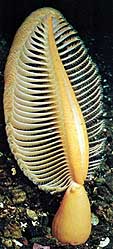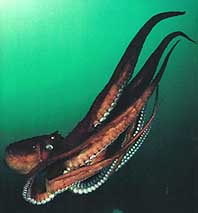There is an exuberance of life in the remarkably fertile
waters of the Strait of Georgia. An inland sea separating mainland Canada from
Vancouver Island, the strait has long been a paradise for sport and commercial
fishermen.
 Slow
staking predator, the leather starfish
Slow
staking predator, the leather starfish
Playground and workplace for British Columbia’s people
(most of whom live near its shores) the Strait of Georgia is fringed with
hundreds of fjords, bays and estuaries. In summer, hundreds of thousands of
local pleasure boats dot its surface, competing for space with fishing boats,
log barges and Alaskan-bound ferries. During the warm summer months, an
abundance of plankton is whipped into a soup by tidal currents, which ebb and
flow through the straits twice a day. During that time, visibility in the
waters can be limited to a metre or less. But when winter casts its pall
across the region, the province’s divers enjoy their best season for their
sport. Winter winds arrive, and that great synthesiser, the sun, stays hidden
behind cloud cover, and the strait’s dense kelp forests begin to die. By
winter’s end, the curtains of plankton have disappeared, and visibility may
extend to a hundred feet in some places.
 When
stroked, this beautiful sea pen will luminesce a soft, glowing green
When
stroked, this beautiful sea pen will luminesce a soft, glowing green
In the shallows of one of the strait’s countless islands,
eel-like penpoint gunnel seek shelter by threading its ten inch body around
the spines of a crimson sea urchin. Brainless beauties, sea anemones such as
the two foot long Metridium senile cling to the walls of living coral.
Thriving in areas of swift current, they poison small, passing animals by
extending microscopic ‘harpoons’ from tentacles. Strawberry anemones
carpet large bottom areas of the strait, and thousands of extended polyps set
up house in colonies of soft coral.
No raving beauty, the six-foot wolf eel lurks in his den,
waiting for hapless spiny sea urchins to float by. Suddenly, snap! With a
great splintering of shell and spine, the thorny creature becomes an unlikely
lunch. Not eels at all, the wolf eel are among the largest of a sub-order of
small gunnels and blennies. Powerful jaws and massive grinding teeth in a
mouth with little soft tissue enables the wolf eel to make mincemeat of spines
which are sharp enough to pierce a scuba diver’s suit.
Among the strait’s most impressive creatures is the
beautiful sea pen, and these beautiful animals are often displayed in public
aquariums. When stroked, they luminesce a soft green, due to a chemical
reaction in their cells.
 The
Pacific’s giant octopus
The
Pacific’s giant octopus
At home in cold water and warm, octopi thrive in the Strait
of Georgia and throughout the Pacific, where they have been known to grow to
150 pounds. Along with the giant squid, which can reach half a ton, the
octopus is the most highly developed of the thousands of mollusc species.
Evidence indicates that they have developed brains, and their eyesight can
rival that of Man. Long considered a delicacy by many of the world’s people,
octopus is gaining popularity in British Columbia’s fish markets.
Hard to miss, especially by night divers, whose lights
catch the gleam from its huge opalescent eyes, is the ratfish, which cruises
by on wing-like pectoral fins. These living fossils are scavengers which share
physical characteristics common to both sharks and true bony fish. The rich
variety of bottom dwellers are abundant in the straits. The clown shrimp finds
a friendly home in the textured anemone. It coats itself with mucus from the
body of the anemone, thereby protecting itself from being devoured by its
friend. Short-changed by nature, the hermit crab lives in ‘hand me downs’.
From birth, their survival depends on other creatures’ shells. As the crab
grows, it seeks a larger shell, and often will tear a living mollusc from its
shell.
Fierce competitors with the shellfish industry are the sea
stars, nearly a hundred species, which thrive in the Straits of Georgia
region. Inhabitants of the strait’s inter-tidal zones, great colonies are
regularly seen exposed on inshore rocks at low tide. To visitors along the
coast of British Columbia’s inland sea, this sight gives the impression that
the marine life is so rich in abundance, it has spilled over into our world.